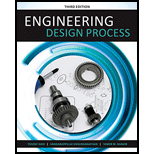
Why would a designer place items (demos of function) in the morphological chart if he or she knows that they would not be feasible?
The purpose of placing items (demos for function) in the morphological chart if he or she knows that they would not be feasible.
Explanation of Solution
In morphological chart every possible solution is placed even though knowing that they might not be feasible to avail those choices whenever a compatible combination is chosen according to a particular theme such as, economy, environment, ergonomics etc..
A compatible solution might not be correct for a particular theme which makes the designer to take all possible combinations into account.
Also every possible combination is represented in morphological chart to identify the solution space of a design problem.
Thus the above discussion states the purpose of placing items (demos for function) in the morphological chart even if he or she knows that they would not be feasible.
Want to see more full solutions like this?
- This is a tilt and rotation question. Here are notes attached for reference.arrow_forwardThe crate of mass m is supported on a cart of negligible mass as shown in (Figure 1). Determine the maximum force P that can be applied a distance d from the cart bottom without causing the crate to tip on the cart. Express your answer in terms of some, all, or none of the variables b, d, h, m, and the acceleration due to gravity g. P B harrow_forwardConsider a pair of pipes running in parallel, through which 1200 GPM flows, which have thefollowing features:Pipe 1: Carbon Steel, Schedule 40, 8" Diameter, 1200 GPM, Water at 44°F, Fittings:2 tees, 2 butterfly valves, 2 pressure gauges with their respective ball valves, 1 valvemotorized balloon. All valves are completely open. Length of the pipe is 6 feet. Pipe 2: consists of a carbon steel bypass pipe, schedule 40, diameter of 4",with the following accessories: 2 elbows long radius of 90° and an open globe valve.The length of the pipe is 10 feet. a) Determine the flow rate in each pipe.b) The pressure drop.arrow_forward
- 1-ft3 of air is contained in a spring-loaded piston-cylinder device. The spring constant is 6 lbf/in, and thepiston diameter is 12 in. When no force is exerted by the spring on the piston, the state of the air is 250 psiaand 450◦F. This device is now cooled until the volume is one-third its original size. Determine the changein the specific internal energy and enthalpy of the air.arrow_forwardThis is a tilt and rotation question. Here are notes attached for reference.arrow_forwardThis is a tilt and rotation question. Here are notes attached for reference.arrow_forward
- I need help with a MATLAB code. For question b.6 I have the MATLAB code shown below. How do I edit the code to answer question b.7. Please make sure the plots are reasonable. clc; clear all; % Constants mu = 398600; % Earth gravitational parameter, km^3/s^2 % Initial chief and deputy positions and velocities in ECI frame % Assume circular orbits in equatorial plane for simplicity a_c = 10000; % km a_d = 11500; % km r_c0 = [a_c; 0; 0]; v_c0 = [0; sqrt(mu/a_c); 0]; r_d0 = [a_d; 0; 0]; v_d0 = [0; sqrt(mu/a_d); 0]; % Initial relative state delta_r0 = r_d0 - r_c0; delta_v0 = v_d0 - v_c0; x0 = [delta_r0; delta_v0]; % 6x1 initial relative state % Time span tspan = [0 3600]; % 1 hour in seconds % Damping cases cases = struct( ... 'name', {'Critically damped', 'Under-damped', 'Over-damped'}, ... 'Kr', {eye(3)*2.5e-3, eye(3)*0.001, eye(3)*0.01}, ... 'P', {eye(3)*0.01, eye(3)*0.0006, eye(3)*0.02} ... ); % Simulate each case for i = 1:length(cases) Kr = cases(i).Kr; P =…arrow_forwardJust do Questions 7, 9, 11. Here are notes attached for reference.arrow_forwardThis is a tilt and rotation question. Here are notes attached for reference.arrow_forward
- Thermodynamics: Mass and Energy Analysis Of Control Volumes A spring-loaded piston-cylinder device contains 1.5 kg of carbon dioxide. This system is heated from 200kPa and 25◦C to 1200 kPa and 300◦C. Determine the total heat transfer to and work produced by this system.arrow_forwardCan you help with a code in MATLAB?arrow_forwardI need help writing a code in MATLAB. Please help me with question b.6arrow_forward
 Precision Machining Technology (MindTap Course Li...Mechanical EngineeringISBN:9781285444543Author:Peter J. Hoffman, Eric S. Hopewell, Brian JanesPublisher:Cengage Learning
Precision Machining Technology (MindTap Course Li...Mechanical EngineeringISBN:9781285444543Author:Peter J. Hoffman, Eric S. Hopewell, Brian JanesPublisher:Cengage Learning
